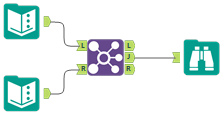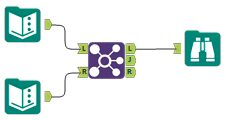 Join Tool
Join Tool
The Join tool combines two inputs based on a common field(s) between the two tables. You can also Join two data streams based on record position.
Configure the tool
- Select how to perform the Join. The two options are by record position, or by specific field.
- Join by Record Position: Select this option when the two tables to be joined have the same field structure, and the data will be joined by its position within the two tables.
- Join by Specific Field: Select this option when the two tables have one or more fields in common (such as an ID) and the data will be joined together. You can choose to Join on multiple fields. Each Join should be a separate row in the grid.
 Potential error messages
Potential error messages
The Join tool restricts what field types can be joined together. The following error messages may result:
- String fields can only be joined to other string fields.
- Numeric fields can only be joined to other numeric fields.
- Boolean fields can only be joined to other boolean fields.
-
DateTime fields types can only be joined to their exact type.
- Spatial fields cannot be joined, use the Spatial Match Tool instead.
- Blob fields cannot be joined to any other type.
- Warning: Joins on Double or Float are not recommended due to rounding error.
Each Input will have a drop down list of its fields. Select the join field for each input. Alteryx will automatically select a join field from an input if the same field name was already selected from a different input.
If multiple join fields are desired, an additional row of join fields can be configured. Simply click on the drop-down to choose additional join field per input.
To delete a join field, click on the number on the left hand side and click the delete button  on the right.
on the right.
- Use the table to modify the incoming data stream. Each row in the table represents a column in the data.
 Select, deselect, and reorder columns
Select, deselect, and reorder columns
To include a column in data, select the check box to the left of the column name. Deselect the check box to exclude the column.
To reorder the columns of data:
- Click to highlight a row, or click and drag down to highlight multiple rows.
- Click the
 or
or  arrows, or right-click and drag, to move the rows to a new location.
arrows, or right-click and drag, to move the rows to a new location.
The Unknown column is selected by default. It allows new columns in the data. Move the column to the location where you want a new column to be.
 Modify data type and size
Modify data type and size
To change the supported length (characters for string and numeric fixed decimal types) or measurement (bytes for other numeric types) of data in a column, click Size and type a number. Size varies by data type and can be edited for fixed decimal numeric types and all string types. See Data Types.
Use the [data type]: Forced option to ensure a column always contains the expected data type; this is helpful when creating macros. See Macros.
 View more options
View more options
After selecting or highlighting rows (columns of data) in the table, click Options to view more configuration options:
- Save/Load: Save the column configuration as a .yxft file. The Alteryx Field Type File is a text file can be used in other workflows using the Load Field Names or Load File Names and Types options.
- Select: Select or deselect all or highlight columns. Options include Select All and Deselect All.
- Change Field Type of Highlighted Fields: Change the data type of all highlighted columns at once.
- Sort: Sort the column order in ascending or descending order. Options include Sort on Original Field Name, Sort on New Field Name, and Sort on Field Type, or Revert to Incoming Field Order.
- Move: Move highlighted columns to the top or bottom of the list.
- Add Prefix to Field Names: Add a prefix to the selected or highlighted column name.
- Add Suffix to Field Names: Add a suffix to the selected or highlighted column name.
- Remove Prefix or Suffix: Remove the prefix or suffix from the selected or highlighted column name.
- Clear All Renames: Remove the new name for all column.
- Clear Highlighted Renames: Remove the new name for all highlighted columns.
- Revert All to Original Type and Size: Undo all changes to type and size in all columns and use the original values.
- Revert Highlighted to Original Type and Size: Undo changes to type and size in the selected or highlighted columns and use the original values.
- Forget All Missing Fields: Remove all columns that are no longer included in the data.
- Forget Highlighted Missing Fields: Remove all highlighted columns that are no longer included in the data.
- Deselect Duplicate Fields: Deselect the second column when duplicate column names exist; this optional is only available with multiple inputs.
View the output
The three outputs resulting from the join are as follows:
 Join Tool
Join Tool![]() on the right.
on the right.











